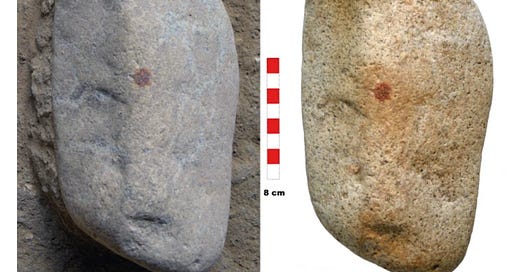Researchers Found A 43,000 Year Old Neanderthal Fingerprint
The print was discovered on a rock that vaguely resembles a human face, and researchers argue it was intentionally placed to represent a nose.
Hiya!
Pareidolia is when we perceive shapes, faces, or meaningful patterns in ordinary, inanimate objects. Well-known examples include the Rorschach test, seeing the ‘man on the moon,’ Jesus on a tortilla, or the ‘face on Mars.’ We also see animals in clouds, symbols in tea leaves, and monsters in the shadows of bare tree branches.
Of all things, however, we humans are especially keen at spotting faces, to the extent that it has its own category called “face pareidolia.” We see faces practically everywhere, in everything.
Now, some scientists are arguing that Neanderthals also experienced face pareidolia, and they have evidence in the form of a fingerprint that may have been intentionally placed in the middle of a rock, which they claim represents a nose on a face.
The Discovery
Today’s story begins in July 2022, on the Iberian Peninsula — one of the last known European areas Neanderthals inhabited before they went extinct — where archaeologists, led by David Álvarez-Alonso at the Complutense University of Madrid, were excavating the San Lázaro rock shelter near Segovia in central Spain.
While walking the site, Álvarez-Alonso and his colleagues noticed a peculiar quartz and granite rock that grabbed their attention. He told Sam Jones of The Guardian,
“The stone was oddly shaped and had a red ochre dot, which really caught our eye. We were all thinking the same thing and looking at each other because of its shape: we were all thinking, ‘This looks like a face.’”
The rock is about 6 inches (15 centimeters) long and resembles a large rustic potato, with two indentations at one end that vaguely resemble eyebrows or eyes, and another at the opposite end that could represent a mouth.
And, as you can see in the image below, smack-dab in the center is a small red dot that could, presumably, depict a nose.

The scientists unearthed the stone to investigate it further onsite, but found no evidence that it was used as an anvil or hammer. In fact, it didn’t resemble any known stone tool at all.
Instead, it seemed to the team that the rock originated elsewhere, likely from a nearby river, and had been deliberately brought to the rock shelter.
Still, Álvarez-Alonso told Jones they knew they needed more evidence. He explained,
“As we carried on our research, we knew we needed information to be able to advance the hypothesis that there was some purposefulness here, this was a symbolic object and that one possible explanation – although we’ll never know for sure – is that this was the symbolisation of a face.”
What began as a curious observation quickly grew to a monumental investigation involving Spanish archaeologists, geologists, and, somewhat surprisingly, police forensic experts.
More specifically, the resulting study, published on May 5, 2025, in Archaeological and Anthropological Sciences, involved archaeologists from the Complutense University of Madrid, geologists from the University of Salamanca and the Geological and Mining Institute of Spain of the Higher Council for Scientific Research, and forensic experts at the General Police Station of the National Police.
The Analysis
When they began, Álvarez-Alonso and his team had three primary questions about the mysterious red dot: What material is the dot made of? How old is it? And, what object was used to create it?



